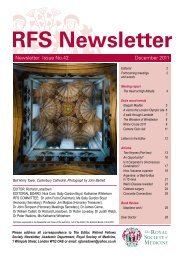Radiofrequency ablation for uncomplicated varicose veins
Radiofrequency ablation for uncomplicated varicose veins
Radiofrequency ablation for uncomplicated varicose veins
Create successful ePaper yourself
Turn your PDF publications into a flip-book with our unique Google optimized e-Paper software.
M S Gohel and A H Davies. RFA <strong>for</strong> <strong>uncomplicated</strong> <strong>varicose</strong> <strong>veins</strong> Original article<br />
Principles of radiofrequency <strong>ablation</strong><br />
Scientific principles<br />
The underlying principle of RFA involves the delivery<br />
of thermal energy derived from an electric<br />
current to the venous segment to be treated. This<br />
is achieved using a bipolar endovenous catheter<br />
with a typical power of 2–4 W, which is used to<br />
generate temperatures of 85–1208C. As the procedure<br />
relies on direct contact between the RFA<br />
catheter and the vein wall, it is essential that the<br />
vein is emptied of blood during <strong>ablation</strong> (achieved<br />
using Trendelenberg position, use of tumescent<br />
anaesthesia and extrinsic compression). There is<br />
an in-built feedback mechanism, which evaluates<br />
the vein wall impedance and can adjust the<br />
energy delivery accordingly to ensure that the<br />
fibre temperature remains consistent.<br />
Ex vivo histological studies of venous segments<br />
treated with RFA demonstrated homogeneous<br />
intimal and medial thermal <strong>ablation</strong> and disintegration.<br />
This differed from <strong>veins</strong> treated with<br />
endovenous laser <strong>ablation</strong>, where major perivenous<br />
tissue <strong>ablation</strong> and vein wall per<strong>for</strong>ations were<br />
present. 1<br />
Available devices<br />
The current market leader <strong>for</strong> endovenous RFA<br />
devices is VNUS w Medical Technologies Inc. (San<br />
José, CA, USA). The VNUS Closure TM catheter has<br />
been available <strong>for</strong> nearly a decade and requires a<br />
continuous pullback technique. This was com-<br />
monly used with a tight compressive rubber<br />
bandage (Esmark w , Hygenic Corp., Akron, OH,<br />
USA) to facilitate venous emptying during treatment.<br />
In 2006, VNUS launched the ClosureFast TM<br />
segmental <strong>ablation</strong> catheter, which allows RFA of<br />
superficial <strong>veins</strong> in 7 cm segments, thus eliminating<br />
the continuous pull-back technique (Figure 1). The<br />
segmental <strong>ablation</strong> has the theoretical advantages<br />
of greater consistency in the vein treatment and<br />
increased speed of <strong>ablation</strong> as each 7 cm segment<br />
can be treated in 20 seconds. It should be noted<br />
that VNUS also market a specific stylet device<br />
(VNUS RFS TM stylet) <strong>for</strong> the <strong>ablation</strong> of incompetent<br />
per<strong>for</strong>ating <strong>veins</strong>. All VNUS catheters may be<br />
used with the VNUS RFG Plus TM generator<br />
(Figure 2).<br />
The Olympus Celon RFITT TM (Olympus Medical<br />
Systems, Hamburg, Germany) is an alternative<br />
RFA system which has been upgraded recently<br />
(Figure 3). The system uses the continuous pullback<br />
technique and claims to treat venous segments<br />
at a pull-back speed of 1 cm/s, although clinical<br />
studies using this new device are scarce.<br />
Description of technique<br />
Although there are broad similarities between the<br />
various endovenous therapies, the location of treatment,<br />
type of anaesthetic and numerous other<br />
factors will be dictated by the personal preference of<br />
clinicians (see Delivering a radiofrequency <strong>ablation</strong><br />
<strong>varicose</strong> vein service below). The generic technique<br />
<strong>for</strong> RFA can be summarized in the following steps:<br />
Figure 1 Illustration of the segmental <strong>ablation</strong> technique using the VNUS ClosureFast TM catheter.<br />
(Reproduced with permission from VNUS)<br />
Phlebology 2009;24 Suppl 1:42–49 43








